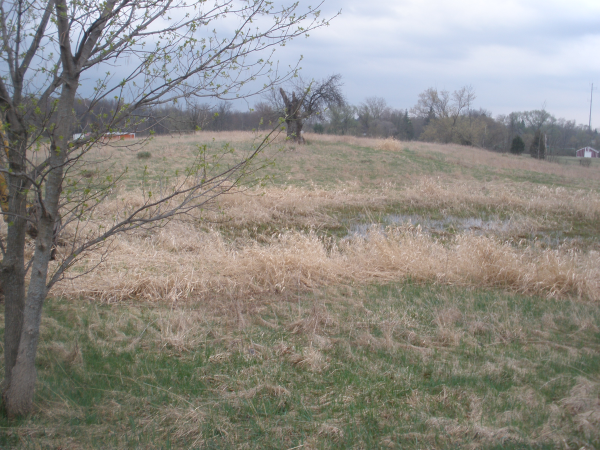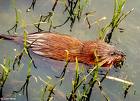Blog with Schlicht Excavating
Scott Schlciht
Recent Posts
 Koi Clay (Bentonite)
Koi Clay (Bentonite)
Bentonite, also known as montmorillonite clay or Koi clay, is used in Koi ponds for various reasons. It is available for water gardening in powder form. Bentonite has coagulating properties, so it will absorb any fine particles that are suspended in the water and it will settle on the bottom of a pond or a filter.
Adding bentonite to a Koi pond is also beneficial to a Koi's immune system, for it has many good minerals in it. Koi get all of their nutrients either from the food they eat or from the water directly. Bentonite can even be added to Koi food to make it have a greater mineral content.
Koi clay (bentonite) can also be used to remove string algae from a stream. Take some of the clay, spread it over where the string algae is growing and it will detach it from the stream bed.
Bentonite is also used as a liner for mud ponds. It is moved in the pond hole with a bulldozer and then tamped until it is about a foot thick so that it forms a waterproof layer.
Bentonite is a rock that is made of claylike minerals. The most common clay minerals in bentonite are members of the smectite group (mostly montmorillonite); other components of bentonite include biotite, feldspars, illite, kaolinite, quartz, and volcanic glass. There are two types of bentonite: swelling bentonite, which is also called sodium or western bentonite, and non-swelling bentonite, which is also called calcium, or southern, bentonite. Both types formed through the alteration of volcanic ash that was deposited in a marine environment. Bentonite is mined mainly in the Western United States and Greece. Most of the bentonite mined in the United States is used in oil and gas well drilling.
4/24/2010

We started this pond in White Lake MI today and finished in about 9 hours. Pond was for a member of a famous detroit band. While digging the pond I found a collection of boulders probly over 100 years old. Farmers had no use for these rocks that now go for over $85 a ton so they would dig a hole and pile them in.
-resized-600.jpg)
-resized-600.jpg)
-resized-600.jpg)
 A pond may serve other useful purposes such as meeting critical water
A pond may serve other useful purposes such as meeting critical waterneeds during a drought, irrigating the garden or orchard, watering
livestock, or even fire fighting. There are intangible benefits such as
enjoying wildlife drawn to small bodies of water.
You don't have to own a large tract of land to consider building a pond.
Of the 15 million ponds already in existence in America, the average size
is only 1/2 acre. It may not sound like much, but our own 1/2-acre pond
is approximately 75 feet wide by 200 feet long, and with an average depth
of eight feet it contains more than a million gallons of water!
The particular pond size you decide on however, probably won't be
dictated by how much money you can afford to spend. Rather, it will hinge
almost entirely upon the lay of the land, the composition of the soil and
underlying strata, and the general suitability of the terrain for
impounding water. These factors dictate what type of earth-moving
equipment will be required to build the pond and the number of hours
needed. As a result of varying terrain conditions, it's possible one
landowner may have to spend only $3,000 to build a five-acre lake while
his neighbor has to cough up $6,000 for only a 1/1-acre pond.
Since the construction of even a small pond can be expensive, legions of
landowners have attempted every imaginable shortcut to reduce costs and,
predictably, horror stories abound. In northern Ohio, for example, a
landowner came up with a not-too-bright answer to shelling out for an
engineer to draw up blueprints and a contractor to do the 'dozer work. He
simply designed his own dam, borrowed a friend's D-6 Caterpillar, and
pushed the dirt into place. The resulting six-acre lake was a beauty for
several years. Then one spring, excessive rainfall raised the pond level.
The spillway couldn't handle the additional water and the makeshift dam
collapsed, sending a torrent of water cascading down a narrow valley. The
flood drowned 20 dairy cows on a neighboring farm, and ruined a barn on
another. Today, five years later, lawsuits are still pending against the
pond-builder.
In another case, this time in Kentucky, a landowner did not follow the
advice of a soil analyst who had warned that the compaction of red clay
in the pond basin would block water seepage. The landowner saved $2,000
but he now has a "dry" pond. When it rains the pond fills up, but several
days after the rain subsides the water begins percolating down through
the soil as if it were a sieve, until nothing remains but a hole in the
ground.
So, the strongest advice I can give anyone contemplating building a pond
is to forget about the one-time expense and foster a determination to do
the job right. Such an approach will undoubtedly prove the least
expensive. And it will result in a pond that is aesthetically pleasing,
safe, sound, and in full compliance with the laws that govern the
impounding of large quantities of water on private property.
That last aspect is critically important to any pond-owner. If a
professional engineer designed the pond and it received approval from one
or more government agency, it's just like having insurance. What I mean
is, if something should go wrong in the future and there is damage to
life, limb, or property, it's not likely you will be held liable.
One way to build a pond on your property is to hire a private engineering
firm that specializes in pond construction. They'll handle everything
from initial site examination to surveying, preparation of blueprints,
and supervision of numerous subcontractors. However, you should know in
advance that this is the most expensive route to take.
The second option, and the one I recommend, is to contact your local Soil
Conservation Service (SCS) office. This is a division of the U.S.
Department of Agriculture and every state has numerous regional and
county offices. Of the many responsibilities charged to SCS offices, one
is supervising the technical aspects of private pond construction.
The SCS will not pay for any of the construction costs, nor will it do
any of the actual work. It will handle all of the professional planning
you'd otherwise pay a stiff fee to have a private engineering firm do.
This includes site examination, soil analysis, surveying, blueprints,
pond and dam specifications, and specifying materials.
With blueprints and specs in hand, you can then contact a local
contractor to begin work. Don't worry if you don't know how to read
blueprints, interpret materials specifications, or anything pertaining to
soil chemistry and pond construction. Your contractor will know these
things, and your SCS official will be on location virtually every day to
oversee operations.
Ponds can be almost any shape, but most are rectangular, round, oval,
triangular, or teardrop-shaped. In flatlands, a large depression is
sometimes scooped out to form the pond basin, and the dam--if there is
one--surrounds the pond. More commonly, an earthen dam is placed between
steep hillsides and the water backs up and inundates a ravine or valley.
As to where the water comes from, the most common sources are surface
springs, underground aquifers, streams, surface run-off from higher
ground, or a combination of these.
A contractor's initial work is to scalp the pond site of its six or eight
inches of valuable topsoil and pile it somewhere for later use. Then,
with stake flags outlining the high-water mark of the pond-to-be and the
centerline of the future dam, dozers begin grading the pond basin to
remove all "refusal" (rock, shale, coal blossom, and unwanted soil types)
until sufficient pond depth is achieved.
A critical aspect of any pond's construction is sealing the basin to
prevent water from escaping and building the dam so that no water leaks
through. This involves dozers pushing thousands of tons of clay into the
pond basin from a nearby "borrow" area, determined from previous soil
test samples. If clay is absent in your region, your contractor may have
to haul truckloads of bentonite to the site at considerable expense.
(Bentonite is a volcanic material that is disked into the soil of the
pond basin; when wet, it swells to several times its original volume and
creates a water-tight seal.)
The dam is created by dozers carving out a T-shaped trench 10 feet deeper
than the deepest part of the pond basin. Layer upon layer of clay or
bentonite is then pushed into place six inches at a time and compacted
with a sheepsfoot roller.
When the dam is two-thirds complete, the spillway system is installed.
It's simply a length of steel pipe running through the dam structure that
allows excess water to escape. Without it, the water level would continue
to rise until it began rushing over the top of the dam, which would cause
serious erosion.
Next is the installation of a toe drain, a length of perforated plastic
pipe that runs through the back side of the dam to collect moisture and
drain it away. Keep in mind that the front of the dam, against the pond
water, is always wet. The toe drain ensures that, should water somehow
begin seeping through the compacted clay, it would not saturate all the
way to the back and undermine the dam's strength.
Finally, an emergency spillway must be built. This is a narrow channel
shooting off one side of the pond that takes over if the steel spillway
becomes clogged or if excessive rainfall is more than it alone can
handle.
When the lake basin and dam are completed, the contractor retrieves the
tons of topsoil that were set aside and carefully grades it over the dam,
around the shorelines, and over the borrow area. Following this, all bare
ground is limed, fertilized, seeded, and mulched to get the dam and
shorelines vegetated as soon as possible to prevent erosion.
All that is left to do now is to wait patiently for the pond to fill with
water, which takes from two months to a year depending upon the size of
the pond, the amount of rainfall, and the productivity of feeder streams
or springs serving the pond.
At this time your SCS office will bow out of the picture. They'll
recommend that you contact your state department of natural resources for
advice on stocking the pond with fish and for a free booklet describing
proper pond management techniques. Stocking your pond is accomplished in
two ways. If legal in your state, you can catch fish at local lakes and
transport them home in a makeshift tank (I used an old camping cooler
fitted with an aerator). Or you can buy fish from a hatchery; your
department of natural resources will supply names of local vendors.
The most compatible species are largemouth bass, channel catfish,
bluegills, and redear sunfish. The most widely accepted ratio is 100 bass
to 500 panfish per surface acre of water. At all costs, do not introduce
white or black crappies, rock bass, bullheads, or the largest predator
gamefish (northern pike or muskies, for example) into your pond. They
will present serious problems in time.
Your fish must have something to eat, so an ecologically sound food chain
should be established. Pond-management handbooks suggest applying
fertilizer to the water, which gives birth to algae bloom and plankton.
These microscopic food items serve as forage for the tiniest insects,
crustaceans, and minnows, which in turn become prey to bass, and panfish
fry, and fingerlings, which then feed larger panfish and bass.
If you want your fish to achieve the most rapid growth rates possible,
you can supplement their natural forage by stocking either golden shiners
or fathead minnows that are one to four inches long. The recommended
amount is 400 minnows per surface acre per year. Always purchase these
baitfish from a commercial supplier who ensures species
purity--attempting to seine minnows from a nearby creek may inadvertently
introduce an undesirable species such as carp or suckers.
According to biologists, a well-managed pond should support a harvest of
20 pounds of bass and 80 pounds of panfish per acre per year. It is
important the panfish be harvested because they reproduce so rapidly that
their numbers will otherwise throw the natural food chain out of balance.
In such cases, all fish inhabiting the water will suffer food shortages
and stunted growth.
If you neglect to heed the advice of qualified pond specialists, your
pond-building experience may be pure misery. But follow their sage advice
to the letter, plant a few evergreens around the shoreline, add a picnic
table as the final touch, and you'll have a little chunk of heaven
Tags: Pond building, Pond digging, before the pond is dug, pond design

Your options will be limited to the species allowed and provided by your Fish and Game division/department. When you stock a private water body, you need a permit from your state government, and your Fish and Game department will provide the fish to be stocked from a hatchery. This process is not like going to the deli -- you can't say, "Give me a bluegill, a couple crappies, and a nice big bass." They will tell you if you can stock fish and what kind of fish you can stock, based on characteristics of the pond, its connection to other waterways, etc. Since this pond is fed by a small stream that means its hydro logically connected to other waterways and the state will want to be careful about what they put in there. Usually nonnative species are not stocked unless they are sterile, which means you have to restock periodically.
If you're not doing this the "official" way, then you're sort of rolling the dice. A lot of unexpected things can happen you embark on a career as an amateur fisheries biologist. Let's say you decide you want bluegill in your pond. You go to some nearby lake and catch a bucket of bluegill, and then you bring them back to your pond. Who knows if they'll survive? Maybe the pH is off or the average temperature is too warm or there's not enough biomass to support fish. They may all die off or they may migrate away through the stream. But let's also say that a few carp larvae got sucked into your bucket of bluegill -- within a few years your pond will be full of carp, and then it won't be fit for anything.
But let's forget about the problems of amateur fish stocking. I'd say that your pond is probably best suited for crappie or perch, which have a high tolerance for temperature variation, can spawn in lots of habitat, and can survive on a wide variety of forage (including each other). They're also good to eat and fun to catch. Here again, however, you run into problems if you just start throwing fish into a pond. The most common problem with sunfish I've seen in small lakes and ponds is overpopulation -- sunfish will fill every ecological nook and cranny and soon you will have an abundance of fish, but only a small percentage will be big enough to fish for.
Tags: Fish, Stocking Fish, Fish Pond
The loaded question, do I need a permit. In most cases it is 50/50 chance weather you need a permit or not. If you are digging a new pond I usually always call the local township and see if there is a permit needed. The MDEQ should be contacted if and when there are wet lands involved.
> 500 feet of a lake or stream
>Within a regulated wet land
>Within a 500 year flood plain
>5 surface acres are bigger
A permit could take up to 3 months to get, but sometimes come in as quick as 30 days with help from Schlicht Excavating. We work with the MDEQ and know most of them on a personal level. If you are just simply cleaning out an existing pond a permit is not needed we just call that a renovation.
You can contact MDEQ at 517-373-9244. You can apply for the permit yourself or contact our firm at 810-845-6070 for assistance.

Aerators:
The most important factor in ensuring successful pond management is proper aeration. Pond aerators provide aeration by agitating the surface of the pond, pulling water up from below and pushing it into the air, producing a large crown of water that saturates with oxygen, then delivers it back into the pond. Proper use of aerators prevents fish stress and mortality, reduces feed costs, removes carbon dioxide and ammonia, and prevents algae growth.

Pond Fountains:
A pond fountain is the perfect solution when the appearance of your pond is just as important as water quality. Similar to aerators, a pond fountain will increase oxygen levels and circulate water by pulling water up from below and pushing it into the air with the added feature of an appealing V-shaped display. A pond fountain not only creates an attractive, relaxing atmosphere, but is also a natural, environmentally safe and cost-efficient way to improve the water quality of your pond lake or water garden without the need for chemicals.

Water Circulators:
The function of a water circulator is to create a directional water flow in your pond or lake to move stagnant water. The movement mixes and agitates the water, spreading oxygenated water, eliminating stagnant areas, and mixing thermally and chemically stratified water. Applications for a water circulator range from keeping debris from accumulating around docks and marinas, reducing unwanted aquatic plant growth and inhibiting mosquito reproduction, limiting the negative affects of spring and fall turnover, and even extending water fowl hunting seasons by keeping an area of water from freezing over.
Tags: Pond Fountain, Water Circulators, Aerators

The muskrat (Ondatra zibethica) is not actually a rat, but is classified as a rodent because of its teeth: four large, yellowish incisors in the front of its mouth. They strive on cat tails and because of this an over grown pond is a paradise for the rodents. This causes conflict between man and rodent. These creatures can be a huge annoyance when they tunnel in your banks and create tunnels for your water to seep pout, and to mention the erosion on the bank that eventually washes into the pond.
Muskrats are in your pond because of a food source. Their diet is a vegetation composed of cattails, water lilies, sedges, and pond weeds, then you may want to get rid of these with a pond clean out. You can try some chemicals or the old fashion way by hand. This is the sure way to get rid of the animals they will seek a more neutral pond elsewhere.
Trapping, is another way to get rid of these muskrats. Trapping muskrat is a very effective way to remove them from your property. Muskrat repellents and electronic device may be marginal. Trapping may be the cheapest route. Call us at pondperfection.com for your trapping needs. In some cases trapping is free of charge depending on the area.
Rip rap the inside of the pond's dam with rocks or cover it with vinyl-coated welded wire. Rocks should be flat and closely-fitted. The rock layer must be at least 8" thick, extending 3 ft. below and 1 ft. above the normal water line. If muskrats are traveling from the pond to feed infields or gardens, fence those areas. A pond aeration or fountain system will also stir up, which the muskrats do not like it will also prevent weed growth.
When a pond gets over grown with weeds and full of sediments from leaves, aquatic weeds, twigs and branches, and decaying organisms such as fish and snails. The pond then needs to be dredged. This usually needs to take place every ten years or so. The dredging process will turn your pond back to its original condition or most times better. In some cases only the edges of the pond need to be dredged. In some severe cases the entire pond would need to be pumped down and cleaned. Depending on the size of the pond this could take a day and up to a week. The spoils that come out of the pond should go somewhere on the property to save time and money. If they need to be hauled away it can sometimes double the cost of the cleanout.
Tags: pond weeds, cleaning pond, cat tails, pond much
